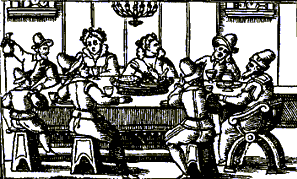

|
|
|
The service in the home on the first night of PESACH. (Passover) is called the Seder.  Seder means order, because great care is taken to carry out the various practices at this service in the right order. The prayer book used on this evening is called an Haggadah which means narration or telling of a story. The main part of this service tells the story of the exodus from Egypt in a way that can be understood by the children present. The story is made more dramatic by the eating of certain symbolic foods, which serve as gastronomic and visual aids for teaching our history. The Seder service takes place in the home and is a happy family gathering at which we celebrate our freedom.
Seder means order, because great care is taken to carry out the various practices at this service in the right order. The prayer book used on this evening is called an Haggadah which means narration or telling of a story. The main part of this service tells the story of the exodus from Egypt in a way that can be understood by the children present. The story is made more dramatic by the eating of certain symbolic foods, which serve as gastronomic and visual aids for teaching our history. The Seder service takes place in the home and is a happy family gathering at which we celebrate our freedom.
The Seder is a happy religious family celebration. Because it takes place in the home it is a unique mixture of serious commemoration of an historical event and a joyful celebration of deliverance from slavery. The various traditional foods and rituals were designed to make both children and parents feel the suffering of slavery and the importance of freedom. As the Haggadah says In every generation people must feel as if they personally came out of Egypt as it is said "You shall tell your child on that day it is because of what the Lord did for me when I went out from Egypt"1.
(1.) The Haggadah is quoting from Exodus 13, 8.
The origins of the Seder go back to the description of the first Passover in Egypt, 2. but the tradition was not continuous as there was a long period when Pesach was not observed at all and had to be reintroduced by King Josiah. 3. In Temple times the first night of Passover was observed in family groups by the roasting and eating of a lamb. This took place in the courts of the Temple in Jerusalem and was observed in this way until the temple was destroyed in 70CE. Jerusalem was crowded at Passover by Jews from distant places.4. The home Seder presumably dates from the time of Yohanan ben Zakkai (late 1st. Century CE) who said that as long as the Temple stood, the altar atoned for Israel, but now a man's table atones for him,5. meaning that Judaism had to carry on by religious observances in the home.
Much of the ritual and prayers of the Seder were already in existence by about 210 CE. For there was a detailed description of these written in the Mishnah.6. Most of the present day seder is defined in the Mishnah. However during Talmudic times the text was not completely fixed, as it was still being discussed by Rav and Samuel.7. Additions and alterations were being made to the "traditional" Haggadah until 16th. century when Chad Gadya was included in the songs at the end. More recently, the Yiddish song Almachtiger Got has virtually disappeared from printed Haggadot in the last century.
(2.) Exodus 12, 1-20. (3.) 2 Kings 23, 22. (4.) Josephus: War, 6, 9, 3. (5.) Ber. 55a, Men. 97a, Chag. 27a. (6.) Pes. ch. 10. (7.) Pes. 116a.
THE ORDER OF THE SEDER. | |||
 1. KADESH Kiddush (Sanctification). |  2. R'CHATS. Washing |  3. KARPAS. 1st. Dipping. |  4. YACHATS. Dividing Matsah. |
 5. MAGID. The Story of the Exodus. |  6. RACHTSAH. Washing Hands. |  7. MOTSI. Grace Before Meal. |  8. MATSAH. Blessings Over Matsah. |
 9. MAROR. Bitter Herb. |  10. KORECH. Hillel's Sandwich. |  11. SHULCHAN ORECH. The Meal. |  12. TSAFUN. Eating Aphikomen. |
 13. BARECH. Grace after Meal. |  14. HALLEL. 2nd. Half of the Hallel. |  15. NIRTSACH. Concluding Parts. |  |
Animation correspond with those in the table above. |
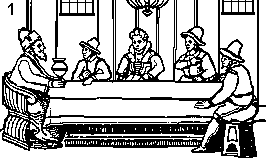 |
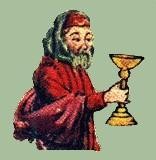
|
Spain c. 1300. |
During the Seder everyone should drink at least four cups of wine. This custom dates back at least to the time of the Mishnah, c. 210 CE, which says: They should give him not less than four cups of wine to drink, even if he receives relief from charity.8. Meaning that even the poorest person should have this number.
See also ELIJAH'S CUP.
What are the reasons for the 4 glasses?
(8.) Pes 10, 1. (9.) Pes. 109b and 117b. (10.) Exodus 6, 6-7. (11.) Daniel 2, 39.
The symbolic foods eaten at the Seder are usually put on a special dish. The exact arrangement of these symbols has varied from place to place and from age to age. Specially designed Seder plates have existed for several centuries and were used by the more affluent Jews, while the less well off used a large dish and arranged the foods on it. Some silver Seder dishes were made with a tray at the top with the symbols and three lower levels underneath where the three pieces of matsah can be placed. It is more usual for families to have two dishes one for THREE PIECES OF MATSAH, which are placed in a matsah cloth with three pockets, and the other for the remaining symbolic foods.
DIFERENT PLATE ARRANGEMENTS | |
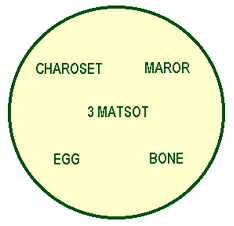 | 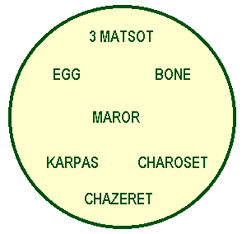
|
There was some disagreement as to precisely which foods were on the dish and how each was placed. So some dishes were made which had a special smaller dish for salt water. But it is more usual to have six foods on the dish.
 A bone (lamb or chicken.)
A bone (lamb or chicken.)
 A roasted Egg.
A roasted Egg.
 The bitter herb
The bitter herb
 a second bitter Herb.
a second bitter Herb.
 a sweet mixture.
a sweet mixture.
 a vegetable for the first dipping.
a vegetable for the first dipping.
The general rule for arranging them on the plate is to put them in such a way, that those symbols which are used earlier in the Seder are nearest to the person leading the service. This based on the saying that one is forbidden la'avor al ha-mitsvah,12. (to pass over a mitsvah). The original meaning was probably that one should not gloss over and not carry out a mitsvah, but here it was taken to mean to stretch ones hand over a mitsvah that has not yet been carried out as if ignoring it.
(12.) S.A. Orach Chayim 673, 4.
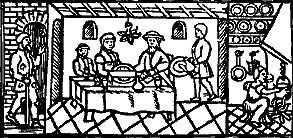
|
|
for Seder, Mantua, . 1560. |
THREE PIECES OF MATSAH are placed on the Seder Table and are covered by a MATSAH CLOTH. Near the beginning of the Seder the middle piece of the three broken in half. One piece is wrapped in a cloth and put aside and the other is put back between the two whole ones. The wrapping in the cloth is sometimes thought of a remind us of how the Israelites wrapped their unbaked dough in cloths when they left Egypt.13. The broken piece is called THE APHIKOMEN. The dish with the two and a half pieces of matsah is then raised and we say This is the bread of affliction, let all who are hungry come and eat� The affliction mentioned was our slavery in Egypt. The mention of the hungry refers to the fact that it has been our custom to invite any Jewish strangers or students to join us for the Seder. It is a time for hospitality, and you never know whether one of them may not be Elijah in disguise.
This declaration, the  Ha Lachma Anya, is in Aramaic and not Hebrew. Aramaic was the spoken language of the Jews for several centuries. This reminds us that it is important to convey the message of Passover in any language that the people understand. 14. Until recently Ashkenazi children often used to ask the four questions in Yiddish.
Ha Lachma Anya, is in Aramaic and not Hebrew. Aramaic was the spoken language of the Jews for several centuries. This reminds us that it is important to convey the message of Passover in any language that the people understand. 14. Until recently Ashkenazi children often used to ask the four questions in Yiddish.
(13.) Exodus 12, 34. (14.) S.A. Orach Chayim 473, 6.
The traditional reasons for these three pieces are:
(15.) Sherira Gaon citing Genesis 18, 6. (16.) Leviticus 2, 4 - 7. (See Kasher: Haggadah Sh'lemah, p. 62.) (17.) Leviticus 2, 11.
The Matsah like the Challah on a Shabbat eve is covered with a cloth. Examples can be seen in two of the illustrations on this site see FOUR QUESTIONS and BREAD OF AFLICTION. During the Seder this cloth is removed and put back at different times. The purpose is to concentrate the attention on the food over which the blessing is said. In the Talmud the example is given concerning bread when making Kiddush.18.
(18.) Pes. 100 a and b.
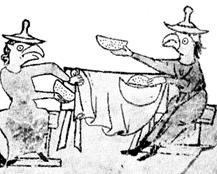
|
|
Germany c. 1300. |
 Aphikomen is the name for the piece of matsah put aside. Aphikomen is the Greek word
Aphikomen is the name for the piece of matsah put aside. Aphikomen is the Greek word  , the meaning of which is not clear. It is thought either to be the name for the entertainment at the end of the meal or else it was the last course.19. The Rabbis were discussing the Mishnah which says After the Seder meal they should not disperse to the Aphikomen20. The present practice follows both interpretations. The half matsah in the cloth is usually hidden and the children then search for it at the end of the meal and are usually rewarded for finding it. This provides the entertainment, which we are not to disperse for. The Aphikomen is then broken into small pieces and everyone eats a piece before saying grace and so this becomes the last course and the taste remains after the Seder.21. The illustration shows that the custom of hiding the Aphikomen is of considerable age. Hiding the Aphikomen also helps to keep the children awake and interested.
, the meaning of which is not clear. It is thought either to be the name for the entertainment at the end of the meal or else it was the last course.19. The Rabbis were discussing the Mishnah which says After the Seder meal they should not disperse to the Aphikomen20. The present practice follows both interpretations. The half matsah in the cloth is usually hidden and the children then search for it at the end of the meal and are usually rewarded for finding it. This provides the entertainment, which we are not to disperse for. The Aphikomen is then broken into small pieces and everyone eats a piece before saying grace and so this becomes the last course and the taste remains after the Seder.21. The illustration shows that the custom of hiding the Aphikomen is of considerable age. Hiding the Aphikomen also helps to keep the children awake and interested.
(19.) Pes. 119b. (20.) Pes. 10, 8. (21.) Maimonides Chamets Umatsah 6, 11.
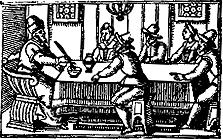
|
|
Celery is being used. |
 Karpas is the salad vegetable used for the first dipping. It is first mentioned in the Mishnah where lettuce was used.22. Rav Amram says the species to be used are radish, rocket, celery, parsley or coriander.23. Other suggestions were carrot tops or boiled potatos24. Various dips have been used. At one time it was common to use Charoset,25. but now it is usual to use either salt water or vinegar. Karpas is not considered a bitter herb and the blessing said over it is for green vegetables rather than for maror. Various reasons for eating it have been suggested:
Karpas is the salad vegetable used for the first dipping. It is first mentioned in the Mishnah where lettuce was used.22. Rav Amram says the species to be used are radish, rocket, celery, parsley or coriander.23. Other suggestions were carrot tops or boiled potatos24. Various dips have been used. At one time it was common to use Charoset,25. but now it is usual to use either salt water or vinegar. Karpas is not considered a bitter herb and the blessing said over it is for green vegetables rather than for maror. Various reasons for eating it have been suggested:
 Karpas written backwards can be read as the
Karpas written backwards can be read as the  letter samech (= 60) with perech meaning rigour or harshness. So it is taken to refer to the 60 myriads of Israelites who served in harsh slavery.
letter samech (= 60) with perech meaning rigour or harshness. So it is taken to refer to the 60 myriads of Israelites who served in harsh slavery.
Remembering that the Karpas is dipped in salt water, we may take the last explanation with a large pinch of salt.
(22.) Pes. 10, 3. (23.) Using Jastrow's identification. (24.) Cecil Roth Haggadah p. 8, and Art Scroll Haggadah p. l. respectively. (25.) eg. Sarajevo Haggadah, c. 1350, Kaufmann Haggadah, c. 1370 and Rylands Haggadah, c.1380.. (26.) Esther 1, 6.
 Mah Nishtanah, The Four Questions that a child asks on Seder night are concerned with:
Mah Nishtanah, The Four Questions that a child asks on Seder night are concerned with:
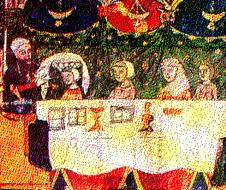
|
|
head. Barcelona, 1350. CLICK on picture to ENLARGE |
(27.) Pes. 10, 4. (28.) Exodus 13, 14 etc.
The Mishnah says According to the son's intelligence his father instructs him.29. This lead to the classification of four types of children. Using the method of the Midrash (drawing meanings from Biblical text) they found four occasions where the father is told to instruct his child about the Exodus.30. For example Exodus 13, 8 says And you shall tell your son in that day, saying, This is done because of that which the Lord did to me when I came forth out of Egypt Because the son does not ask a question, the Haggadah assumes that he was unable to ask. It is of course sad that in the distant past they referred only to sons, as very little effort was made to give girls a Jewish education.
The Haggadah illustrations of the four sons is very interesting. The  Hacham, Wise Son is usually shown with his head in a book and with a long beard as if he were an octogenarian. The
Hacham, Wise Son is usually shown with his head in a book and with a long beard as if he were an octogenarian. The  Rasha, Wicked Son was usually shown as a soldier often in the military dress of the period. In more recent times various other kinds of wickedness have been shown. (See below).
Rasha, Wicked Son was usually shown as a soldier often in the military dress of the period. In more recent times various other kinds of wickedness have been shown. (See below).
WICKED SONS | ||||
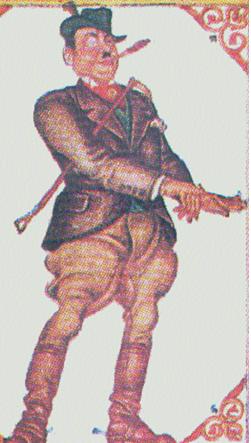 | 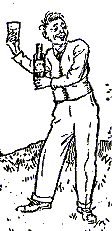 |  | 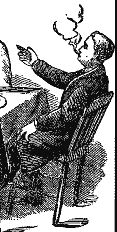 |  |
Poland, 1939. | London, 1937. | USA, 1920. | Tilting chair. Chicago.1883. | Mantua, 1560. |
(29.) Pes. 10, 4. (30.) Deut. 6, 20; Exodus 12, 26-7; Exodus 13, 14; Exodus 13, 8 (in this order).
WHY does the number four occur so many times in the Seder ritual? We have:
The answer is that it is probably pure chance. Each four has an explanation of its own and they are not interconnected. It is possible to make almost as good a case for the number three. For we have:
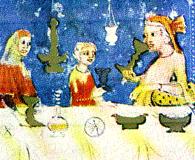
|
|
on yellow cushion. South Spain, c. 1350. |
The custom of leaning at the Seder is symbolic of freedom which dates back to Roman times. At that time it was the custom at banquets for freemen to recline on couches to eat, while their slaves stood in the background serving the food. Leaning is mentioned in the Mishnah. Even the poorest man in Israel must not eat [on the night of Passover] until he reclines31.
The Talmud gives more details and says that we should lean on the left side32. because it aids digestion. However the reason was probably because most Jews were right-handed. Leaning to the left meant that the right hand was free to feed with. The Talmud33. links leaning with freedom. This is the basis for the present custom where we lean for those foods which symbolise freedom eg. Wine but not for those concerning slavery eg. Maror. We lean for eating Matsah because although the dough was made while in slavery, it was not finally baked until they were on the journey out of Egypt.34.
(31.) Pes. 10, 1. (32.) Pes. 108a. (33.) Pes. 108a. (34.) Exodus 12, 39.

|
|
Kaufmann Haggadah. c. 1370. (Note the wrong vowel) |
 Z'ro'a, the lamb bone, goes back about 3,270 years to THE FIRST PASSOVER in Egypt when a lamb was killed, roasted and eaten.35. For the development of this practice see HISTORY OF THE SEDER. Since the destruction of the temple in 70 CE no sacrifices have taken place but a lamb bone was placed on the table as a reminder of the old practice. The bone used is usually the shank bone from the shoulder of the lamb. For this reminds us of the Z'ro'a n'tuyah the outstretched arm of God with which he was said to have brought us out of slavery.36. The origin of the lamb was probably the thank offering of our nomadic shepherd ancestors, which they made even longer than 3,270 years ago, at the lambing season which falls at Passover.
Z'ro'a, the lamb bone, goes back about 3,270 years to THE FIRST PASSOVER in Egypt when a lamb was killed, roasted and eaten.35. For the development of this practice see HISTORY OF THE SEDER. Since the destruction of the temple in 70 CE no sacrifices have taken place but a lamb bone was placed on the table as a reminder of the old practice. The bone used is usually the shank bone from the shoulder of the lamb. For this reminds us of the Z'ro'a n'tuyah the outstretched arm of God with which he was said to have brought us out of slavery.36. The origin of the lamb was probably the thank offering of our nomadic shepherd ancestors, which they made even longer than 3,270 years ago, at the lambing season which falls at Passover.
After 70 CE we were not permitted to eat roast lamb at the Seder meal lest someone might think that it had been sacrificed. There are some families who for the same reason use a chicken bone. Some vegetarians do not have a bone at all and fill the empty space on the plate with some notice or symbol to remind the family of the past practice. For it can not be ignored completely as Rabbi Gamaliel said unless one has explained three things at the Seder (the Paschal Lamb, the Matsah and the Maror) one has not fulfilled ones duties on Seder night.37.
(35.) Exodus 12, 3 - 14. (36.) Exodus 6, 6. And Deut. 26, 8. (37.) Pes. 10, 5.
 Betsah, the egg as a symbol is not as old as the others on the Seder plate. It is not mentioned in the Mishnah or the Talmud. The custom appears later than 1000 CE. (Maimonides did not know of it.) The explanations given for it are:
Betsah, the egg as a symbol is not as old as the others on the Seder plate. It is not mentioned in the Mishnah or the Talmud. The custom appears later than 1000 CE. (Maimonides did not know of it.) The explanations given for it are:
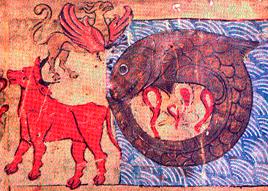
|
|
right: Wild ox, Ziz and Leviathan Ulm,Germany . 1238. |
It is the custom in some Ashkenazi families to serve a hard-boiled egg in salt water as the first course of the Seder meal. Strictly speaking it is not one of the required symbols of the Seder, but only a culinary custom introduced at a later date. The reasons given for this custom are the three mentioned above, to which they added:
The egg, like the KARPAS and the CHAZERET, may also symbolise the renewal of nature in the spring. In this it may be linked to the Christian Easter egg, with both coming from the same nature symbolism.
(38.) Pes. 114b. (39.) Jacob Moelin (40.) Apocalypse of Baruch 29, 4. (41.) Kasher: Haggadah Shlemah p.65.
 Maror, Bitter Herb is eaten at the Seder to remember the bitterness of the lives of the Israelites when they were slaves in Egypt. The custom of eating these is derived from the biblical verse concerning the eating of lamb on the first Passover in Egypt: And they shall eat the meat in that night, roast with fire, and unleavened bread; and with bitter herbs they shall eat it.42. By the time of the Mishnah and Talmud 43., the Rabbis were already discussing what plants qualified as bitter herbs. It is often difficult to know precisely which modern species corresponds to the original Hebrew or Aramaic names. Danby's translation of the Mishnah lists 44. the plants as lettuce, chicory, pepperwort, snakeroot or dandelion while the Soncino Talmud 45. adds to this list endives, chervil, thistles, various species of ivy, and plants with silvery leaves and a bitter sap. There were several other named species which are not identifiable with any certainty. The Kitsur Shulchan Aruch says horse radish is usually used. 46.
Maror, Bitter Herb is eaten at the Seder to remember the bitterness of the lives of the Israelites when they were slaves in Egypt. The custom of eating these is derived from the biblical verse concerning the eating of lamb on the first Passover in Egypt: And they shall eat the meat in that night, roast with fire, and unleavened bread; and with bitter herbs they shall eat it.42. By the time of the Mishnah and Talmud 43., the Rabbis were already discussing what plants qualified as bitter herbs. It is often difficult to know precisely which modern species corresponds to the original Hebrew or Aramaic names. Danby's translation of the Mishnah lists 44. the plants as lettuce, chicory, pepperwort, snakeroot or dandelion while the Soncino Talmud 45. adds to this list endives, chervil, thistles, various species of ivy, and plants with silvery leaves and a bitter sap. There were several other named species which are not identifiable with any certainty. The Kitsur Shulchan Aruch says horse radish is usually used. 46.
The amount of Maror which is required to be eaten is an olive's bulk. Do not cheat on this. Remember that olives in Israel grow large. The herbs used have varied in different communities and in different ages. For those with botanical knowledge may like to try to identify the pictures below.
(42.) Exodus 12, 8. See also Numbers 9, 11. (43.) Pes. 39a. (44.) Pes 2, 5. (45.) Pes. 39a. (46.) Book 3, 118, #3.
CAN YOU IDENTIFY THESE BITTER HERBS ? | |||||||
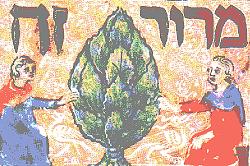
| 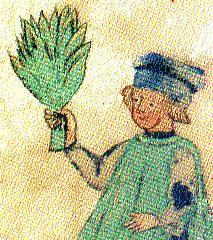
| ||||||
| 2. Germany, c. 1450. | |||||||
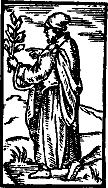 |
|  |
| ||||
| 3. Mantua, 1560 | 5. Copenhagen, 1739. | ||||||
| ||||||
leaves (Cedric R) | to seed | |||||
(S. Wilson) | (SuzanneF) | (SuzanneF) | (SuzanneF) | |||
(SuzanneF) | ||||||
 Charoset is the name a brown paste made of fruits and nuts which is used to temper the taste of the bitter herb. The usual explanation is that it reminds us of the clay from which the Hebrew slaves made bricks. This is the explanation of Rabbi Jochanan which is found in the Talmud.47. While Rabbi Levi linked it to the apple tree in Egypt under which the Hebrew women gave birth.48.
Charoset is the name a brown paste made of fruits and nuts which is used to temper the taste of the bitter herb. The usual explanation is that it reminds us of the clay from which the Hebrew slaves made bricks. This is the explanation of Rabbi Jochanan which is found in the Talmud.47. While Rabbi Levi linked it to the apple tree in Egypt under which the Hebrew women gave birth.48.

| |
Charoset was used for a dip in the times of the Mishnah.49. It is not a food that has to be eaten like the Matsah or the Maror, but it is a long standing custom. Rabbi Levi's explanation implies that about 300 CE apples were used in making Charoset. Amongst Ashkenazi Jews the most usual recipe is Apples, Chopped nuts, Cinnamon, red wine and sugar. Some purists do not use cinnamon powder instead they grate cinnamon sticks so that the slivers of cinnamon remind them of the straw that was mixed into the bricks.50. Various recipes are used throughout the Jewish world. I recommend an Israeli recipe 51. which consists of:
This mixture produces a brown sticky muddy clay which is delicious. The quantities given provide the family with a dessert as well.
(47.) Pes. 116a. (48.) Pes. 116a. and for the apple tree Sot. 11b. (49.) Pes. 10, 3. (50.) S. A. Orach Chayim 473, 5. (51.) Jewish Cooking for Pleasure, Molly Lyons Bar-David p. 146.
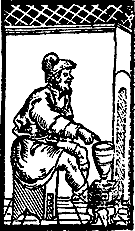
|
wine, Based on Mantua, 1560. |
During the telling of the story of the exodus, we name each of the ten plagues. As we do so we dip a finger into our cup of wine and remove one drop for each plague. The reason for this is that in order that we should be free others (the Egyptians) had to suffer. Wine is the symbol of joy and so their suffering reduces our joy.52.
Sometimes the drops of wine are poured out, but most usually a finger is used. Some link this to the phrase the finger of God53. which was used to describe the plagues.
(52.) Abarbanel's commentary. (53.) Exodus, 8, 15.
 Chazeret, lettuce is mentioned in the Mishnah.54. But there, it appears to have been used for the first dipping that of
KARPAS. The description of the first Passover said of the lamb with unleavened bread and bitter herbs shall you eat it.55. The fact that it speaks of herbs in the plural implies that more than one type of herb is required. And so the Chazeret is the second bitter herb.
Chazeret, lettuce is mentioned in the Mishnah.54. But there, it appears to have been used for the first dipping that of
KARPAS. The description of the first Passover said of the lamb with unleavened bread and bitter herbs shall you eat it.55. The fact that it speaks of herbs in the plural implies that more than one type of herb is required. And so the Chazeret is the second bitter herb.
(54.) Pes. 10, 3. (55.) Exodus 12, 8. & Numbers 9, 11.
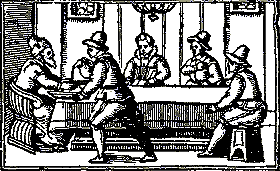
|
On two occasions during the Seder hands are washed, but neither of them is a special custom for Passover. It is the custom before saying grace before meals to wash one's hands. This is partly for ritual purposes and partly for hygiene. As this was seen as a commandment, a blessing is said concerning the action. The other occasion is before dipping food into liquid (in this case dipping Karpas.) This is seen as a custom rather than a commandment and no blessing is required. Many authorities say that only the person leading the Seder is required to wash on this occasion.
Two blessings are necessary over the Matsah. The first, the Motsi, is the grace before a meal. It speaks of lechem, bread, for Matsah is unleavened bread. The second blessing is to show that we are aware that eating of Matsah on the first eve of Pesach is a positive commandment.
After having saying two blessings over the Matsah and eating it, and having said one over the Maror and eaten it dipped in Charoset, then we eat bitter herb with two pieces of Matsah. We say:56. Thus Hillel used to do when the Temple was still standing, he would put together some Paschal lamb, some Matsah and some Maror and the eat them together to fulfil what it says "With unleavened bread and bitter herbs shall you eat it (the Paschal Lamb)57."
The verse quoted does not justify our present practice. So why do we have two pieces of Matsah?
One might think that the present custom was introduced shortly after 70 CE but it is not mentioned in the Mishnah. In the Talmud differing views were expressed by Rabbi Johanan and Rav Ashi (d. 427 CE) as to whether one had fulfilled ones religious duties by just eating these three foods together or whether one should eat them separately with their own respective blessings. Because the matter was not decided conclusively 58. it was decided to play safe do both. So first we eat them separately and then together in Hillel's sandwich. This custom therefore dates from the 5
(56.) Paraphrase of a passage on Pes. 115a. (57.) Numbers 9, 11. (58.) Pes. 115a.
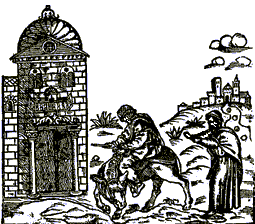
|
the Messiah with shofar. Mantua, 1560. |
An extra cup is placed on the table and this is set aside for Elijah. Elijah was taken up to heaven alive59. So there is a tradition that he is wandering the earth disguised as a poor beggar and waits to announce the future age of the Messiah, when there will be justice, freedom and peace for all.
There was a debate between Rabbis as to whether we should have four or five cups of wine.60. It has been pointed out that in Exodus there is a fifth promise I will bring you into the land 61. This argument was not decided and in such cases the rabbis waited for it to be ruled on by Elijah. Hence this is called the cup of Elijah. For several centuries some Jews had a fifth cup of wine62. over which they said the Great Hallel (Psalm 136). The fifth cup appears in Haggadot from the time of Rav Amram (9th cent) and of Saadia Ha-Gaon (10th Cent.)
(59.) 2 Kings, 2, 11. (60.) Kasher, Haggadah Shelemah, p. 94f. (61.) Exodus 6, 8. (62.) S.A. Orach Chayim 671, 1 (Isserles); Maimonides, Mishne Torah, Chamets umatsah, 8, 10.
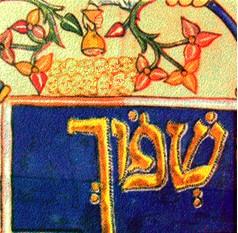
|
Kaufmann Haggadah c. 1370. |
The custom of opening the door after the third cup of wine has been drunk is probably the last of the customs added to the Seder ritual. The Amsterdam Haggadah of 1695 was probably the earliest to include instructions for doing this. Long before this various verses were included at this point beginning with Pour out Your wrath on the nations which do not know You and the kingdoms which do not call on Your name.63. The number of verses included varied from age to age and from place to place. In the 9th Century the Haggadah of Rav Amram had just two verses.
During the persecutions of the Jews in the middle ages extra verses were added. It is not clear how long before 1695 the custom of opening the door began. The Mantua Haggadah of 1560 at this point has a PICTURE OF ELIJAH welcoming the Messiah to Jerusalem with the gate of Jerusalem open behind them. Was the gate open to show that the Messiah was welcome or because the custom had already started?
The Reasons for opening the door are:
Liberal and Reform Haggadot have omitted these verses and a few Orthodox Rabbis have also recommended dropping them as inappropriate for our times. Instead the Progressive movements usually refer to:
(63.) Psalm 79, 6. (64.) Exodus 12, 42. (65.) ULPS Haggadah, 1981, p. 48.
Passover is described in the Kiddush as z'man cherutenu, the season of our freedom. At the Seder we have various symbols which emphasize our freedom.
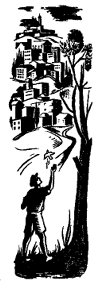 |
The dove of peace. Zim Haggadah, 1952. |
Towards the end of the Seder we say  L'shanah ha-ba'ah birushayim, Next Year in Jerusalem. Some Jews take this literally and think of the geographical Jerusalem where the Paschal sacrifice was originally offered. Other Jews think of the spiritual Jerusalem or the ideal Jerusalem , where all will be free and oppression be no more. (The concept of Blake's Jerusalem) So at the end of the Seder we return to the theme of Passover expressed in the opening prayer of Ha Lachma Anya in which we said This year many are enslaved,
L'shanah ha-ba'ah birushayim, Next Year in Jerusalem. Some Jews take this literally and think of the geographical Jerusalem where the Paschal sacrifice was originally offered. Other Jews think of the spiritual Jerusalem or the ideal Jerusalem , where all will be free and oppression be no more. (The concept of Blake's Jerusalem) So at the end of the Seder we return to the theme of Passover expressed in the opening prayer of Ha Lachma Anya in which we said This year many are enslaved,  Ha-shanah ha-ba'ah b'nei chorin, Next year as free people.
Ha-shanah ha-ba'ah b'nei chorin, Next year as free people.
The Seder concludes with a number of Songs. These were mostly introduced by the Ashkenazi Jews. Some are of a religious nature, while others seem to be little more than children's songs. Some are alphabetically arranged, one is numerical and another is like "The House that Jack Built" or "There Was An Old Woman Who Swallowed a Fly". Attempts have been made to interpret them in a Jewish way, so Chad Gadya was taken to refer to the various nations that persecuted the Jews. However, others think that they were included just for the children.
It possible to get some approximate dates for these songs by looking when they were first included into the Haggadah. I have compiled the following table:
| HAGGADAH | DATE | BA-CHATSI HA-LAILA | TEM ZEVACH PESACH | NA'EH | HU | TIGER GOT | MI YODE'A? | GADYA |
| JOEL ben SIMEON | 1450 | | | |||||
| FARISSOL | 1480 | |||||||
| ASHKENAZI | 1480 | |||||||
| PRAGUE | 1526 | | ||||||
| MANTUA | 1560 | | ||||||
| VENICE | 1609 | | ||||||
| AMSTERDAM | 1695 | | ||||||
However, the first time that they appeared in the Haggadah was not always the date of composition, and Idelsohn 66. dates the songs as:
(66.) Jewish Liturgy, pp. 185-6. (67.) Haggadah, p.75.
The Seder is very much centred on the children. Two traditional parts put in for their benefit were THE FOUR QUESTIONS. and the search for the THE APHIKOMEN. Some of the CONCLUDING SONGS. were included for children and the use of the gastronomical teaching aids were also introduced for the young. The many illustrations in Haggadot, some of which occur on this web site, were probably included to keep the interest of the children. The following decoration from the Ashkenazi Haggadah of 1480 is not only a work of art but it is also an early example of a child's puzzle. For it could well have been entitled:
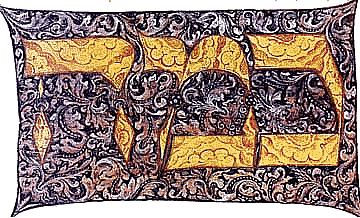
THE FIRST EVENING OF PASSOVER AND THAT THE FESTIVAL LASTS FOR SEVEN DAYS. |
MINUTE DETAILS OF THE RITUAL THAT YOU FORGET ABOUT PASSOVER'S CENTRAL MESSAGE OF FREEDOM. |
The matsah used for the background of this page is genuine and was certified by a Beth Din as being Kasher Lefesach (Kosher for Passover). The piece of matsah was placed directly into the scanner and a portion of the scanned image was tiled. However the scanner was not checked over beforehand to see whether it was free from chamets (leavening).
| FOR FULL ALPHABETICAL INDEX OF CUSTOMS |